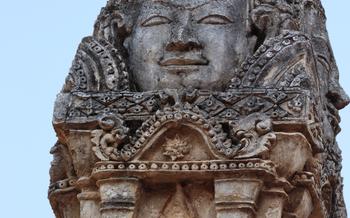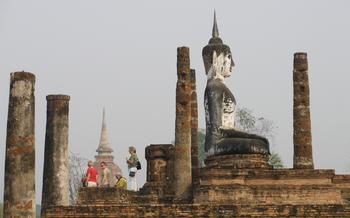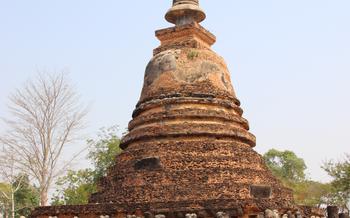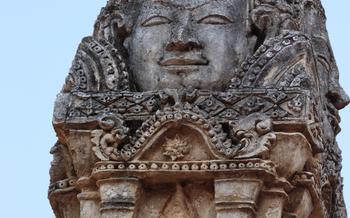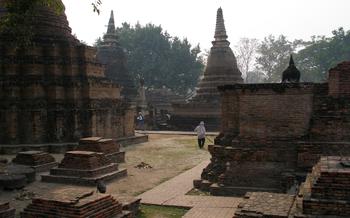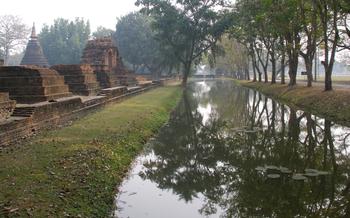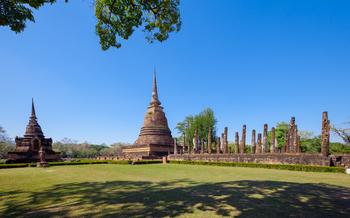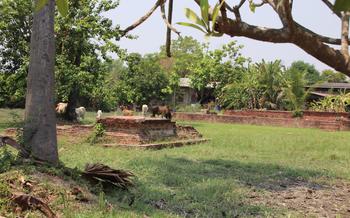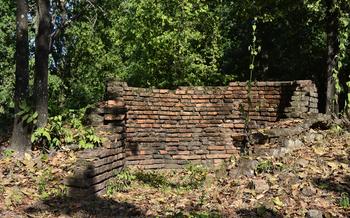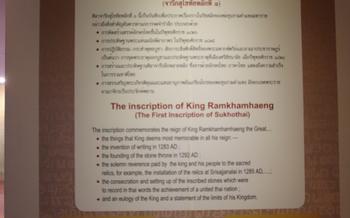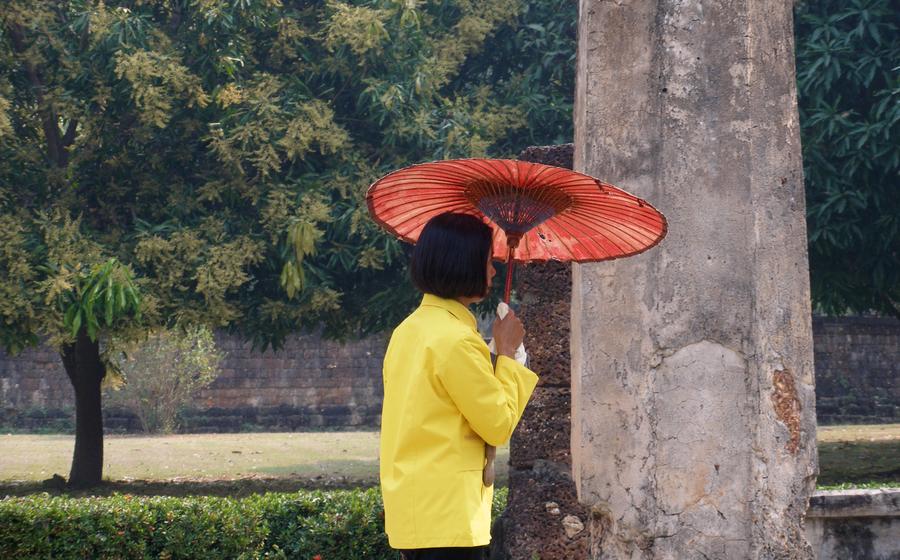
Sawankhalok Pottery Village
- Sukhothai: A Timeless Realm of Artistic Legacy
- Sawankhalok Pottery Village: An Artisan's Haven
- A Village Steeped in History
- A Diverse Range of Pottery Creations
- A Cultural Hub of Artistic Expression
- Exploring the Village's Pottery Workshops
- Unveiling the Secrets of Sawankhalok Pottery
- Hands-On Pottery Experience: Unleashing Your Inner Artisan
- Shopping for Exquisite Sawankhalok Pottery
- Sawankhalok National Museum: A Journey Through Time
- Wat Sri Chum: A Temple Adorned with Pottery Masterpieces
- Wat Chang Lom: A Haven of Ancient Pottery Treasures
- Local Markets and Bazaars: A Shopper's Delight
- The Artistry of Sawankhalok Pottery
- Accommodation and Dining Options
- Planning Your Visit: Essential Tips
- Insider Tip: Unveiling Hidden Gems
Sukhothai: A Timeless Realm of Artistic Legacy
Nestled amidst the fertile plains of central Thailand, Sukhothai, a UNESCO World Heritage Site, captivates visitors with its rich history, architectural marvels, and a flourishing pottery tradition that dates back to the 13th century. As the former capital of the Sukhothai Kingdom, the city exudes an aura of grandeur and serves as a living testament to the kingdom's artistic legacy.
The Sukhothai period witnessed a flourishing of arts and crafts, with pottery emerging as a prominent expression of the kingdom's cultural identity. Skilled artisans crafted exquisite pottery pieces that showcased their mastery of form, function, and design. These creations were not merely utilitarian objects but also works of art, adorned with intricate patterns, vibrant glazes, and symbolic motifs.
Sawankhalok, a town located just 50 kilometers from Sukhothai, emerged as the epicenter of this pottery tradition. Renowned throughout the kingdom and beyond, Sawankhalok pottery became synonymous with artistic excellence and craftsmanship. Its distinctive celadon glaze, with its characteristic shades of green, earned it widespread recognition and appreciation.
Over the centuries, the pottery-making techniques developed during the Sukhothai period have been passed down from generation to generation, ensuring the continuity of this ancient craft. Today, Sawankhalok remains a thriving pottery village, where artisans continue to create stunning works of art, preserving the legacy of their ancestors and contributing to Thailand's rich cultural heritage.
Sawankhalok Pottery Village: An Artisan's Haven
Nestled amidst the verdant landscapes of Sukhothai, the Sawankhalok Pottery Village stands as a testament to Thailand's rich artistic heritage. Renowned as a hub of pottery craftsmanship, the village has garnered a reputation for producing exquisite pottery items that have captivated collectors and enthusiasts worldwide.
A Village Steeped in History
The village's pottery tradition dates back to the Sukhothai period, when it emerged as a prominent center of ceramic production. Over the centuries, Sawankhalok pottery has evolved and flourished, becoming an integral part of Thai culture and craftsmanship. The village's artisans have honed their skills and techniques over generations, passing down their knowledge and expertise from father to son.
A Diverse Range of Pottery Creations
Sawankhalok pottery is renowned for its diverse range of items, each showcasing the village's unique artistic style. From delicate vases and intricate figurines to functional tableware and decorative ornaments, the pottery produced here encompasses a wide spectrum of shapes, sizes, and designs. Whether you seek a timeless piece for your collection or a practical item to adorn your home, Sawankhalok pottery offers something for every taste and preference.
A Cultural Hub of Artistic Expression
Beyond its economic significance, the Sawankhalok Pottery Village holds immense cultural value. It serves as a living museum, showcasing the artistry and craftsmanship that have been passed down through generations. The village's workshops and studios provide a glimpse into the creative process, where visitors can witness skilled artisans transforming ordinary clay into exquisite works of art. The village's pottery tradition is not merely a means of livelihood but an expression of cultural identity, deeply rooted in the community's history and traditions.
Exploring the Village's Pottery Workshops
Sawankhalok Pottery Village is a haven for pottery enthusiasts, offering a unique opportunity to witness skilled artisans at work. The workshops in the village are a testament to the enduring legacy of Thai craftsmanship, where visitors can observe the intricate process of pottery making firsthand.
As you enter the workshops, you'll be greeted by the rhythmic sounds of spinning pottery wheels and the gentle hum of kilns. The artisans, with their deft hands and years of experience, transform lumps of clay into exquisite works of art. Watch as they shape the clay, mold it into various forms, and carefully apply intricate designs.
The workshops provide a glimpse into the traditional techniques that have been passed down through generations. From the initial preparation of the clay to the final firing process, each step is carried out with precision and care. The artisans take pride in their work, ensuring that each piece is a unique expression of their artistry.
Visiting the pottery workshops in Sawankhalok is not just an educational experience but also a deeply immersive one. You'll have the chance to interact with the artisans, learn about their techniques, and gain a deeper appreciation for the skill and dedication that goes into creating each piece of pottery.
Unveiling the Secrets of Sawankhalok Pottery
The allure of Sawankhalok pottery lies in its unique characteristics that set it apart from other ceramic traditions. One defining feature is the distinctive celadon glaze, which gives the pottery a characteristic green to bluish-green hue. This glaze is achieved through a complex process involving the application of a special clay slip and firing at high temperatures.
Beyond its color, Sawankhalok pottery is renowned for its intricate designs and patterns that adorn its surface. These designs often draw inspiration from nature, featuring motifs such as flowers, plants, and animals. The artisans' skillful application of these motifs creates a sense of depth and texture, adding visual interest to each piece.
Furthermore, the symbolism and cultural significance embedded in the motifs used in Sawankhalok pottery add another layer of depth to this traditional craft. Many of these motifs hold auspicious meanings, representing good luck, prosperity, and protection. This symbolic value makes Sawankhalok pottery not only aesthetically pleasing but also culturally significant, reflecting the beliefs and values of the Thai people.
Hands-On Pottery Experience: Unleashing Your Inner Artisan
At the Sawankhalok Pottery Village, visitors have the exceptional opportunity to participate in hands-on pottery-making workshops, immersing themselves in the ancient art form and creating their unique pottery pieces. Under the guidance of experienced artisans, participants are taken through the intricate process of pottery making, from selecting the clay and shaping it on the potter's wheel to firing and glazing.
These workshops provide a glimpse into the traditional techniques passed down through generations, allowing visitors to gain a deeper appreciation for the skill and artistry involved in creating Sawankhalok pottery. The satisfaction of crafting your own pottery piece, which you can cherish as a unique souvenir, is an unforgettable experience.
Whether you are a seasoned potter or a complete novice, these workshops offer a welcoming and supportive environment to learn, experiment, and unleash your inner artisan. The hands-on experience not only allows you to create a tangible memento of your time in Sukhothai but also provides a profound understanding of the cultural heritage and artistic traditions of Thailand.
Shopping for Exquisite Sawankhalok Pottery
The village of Sawankhalok is a treasure trove for pottery enthusiasts, with numerous shops and galleries showcasing a diverse array of pottery items. From traditional celadon wares to contemporary designs, there is something to suit every taste and budget.
When shopping for Sawankhalok pottery, it is essential to take the time to browse the various shops and compare prices. Bartering is acceptable, so don't be afraid to negotiate a fair price with the artisans.
To ensure you are purchasing high-quality and authentic pottery, look for pieces with a smooth glaze and intricate designs. Avoid items with cracks or chips, as these may indicate poor craftsmanship or damage during firing.
Whether you are looking for a unique souvenir or a special gift, the pottery shops in Sawankhalok offer an abundance of choices. Take your time to explore the village, engage with the friendly artisans, and discover the beauty and craftsmanship of Sawankhalok pottery.
Sawankhalok National Museum: A Journey Through Time
The Sawankhalok National Museum stands as a testament to the enduring legacy of Sukhothai's pottery heritage. Dedicated to preserving and showcasing the region's rich ceramic traditions, this museum houses an impressive collection of ancient pottery artifacts and historical exhibits. Visitors can embark on a journey through time as they explore the museum's galleries, gaining insights into the cultural and social context that shaped the development of Sawankhalok pottery.
The museum's collection encompasses a diverse range of pottery items, from everyday household objects to intricate decorative pieces. Each artifact tells a story of the skill and artistry of the ancient potters who created them. The exhibits also shed light on the various techniques and processes used in the production of Sawankhalok pottery, providing a deeper understanding of the craftsmanship that went into each piece.
Beyond its collection, the Sawankhalok National Museum serves as a repository of Thailand's artistic heritage. It plays a vital role in preserving and promoting the unique identity of Sawankhalok pottery, ensuring that future generations can appreciate and learn from this remarkable tradition.
Wat Sri Chum: A Temple Adorned with Pottery Masterpieces
Amidst the serene landscape of Sukhothai, Wat Sri Chum stands as a testament to the fusion of religious devotion and artistic expression. This ancient temple captivates visitors with its stunning pottery decorations that adorn its exterior, transforming it into a canvas of intricate designs and bas-reliefs.
As you approach the temple, your gaze is drawn to the elaborate pottery decorations that grace the temple's facade. The intricate designs depict various scenes from Buddhist mythology and folklore, each tile meticulously crafted and arranged to create a harmonious narrative. The bas-reliefs showcase the exceptional artistry of Sukhothai's potters, who skillfully transformed clay into a medium of storytelling and spiritual expression.
Stepping inside the temple, you are enveloped by a sense of awe and tranquility. The walls are adorned with more pottery masterpieces, each piece unique in its design and symbolism. The pottery decorations seamlessly blend with the temple's architectural features, creating a cohesive and visually stunning space that invites contemplation and reflection.
Wat Sri Chum serves as a living testament to the enduring legacy of Sawankhalok pottery. Its pottery decorations have withstood the test of time, embodying the artistry, devotion, and cultural heritage of the Sukhothai Kingdom. A visit to this sacred site offers a glimpse into the profound connection between art and spirituality, leaving visitors with a lasting impression of the beauty and intricacy of Sawankhalok pottery.
Wat Chang Lom: A Haven of Ancient Pottery Treasures
Among the many temples in Sukhothai, Wat Chang Lom stands out as a unique repository of ancient pottery artifacts. The temple's grounds are adorned with a collection of pottery stupas and chedis, each showcasing the exceptional craftsmanship of the Sawankhalok potters. These pottery structures, with their intricate designs and glazed surfaces, have withstood the test of time, serving as a testament to the enduring legacy of Sukhothai's pottery heritage.
The historical significance of Wat Chang Lom extends beyond its pottery collection. The temple itself is believed to date back to the 14th century, making it a contemporary of the Sukhothai Kingdom. It is thought to have been a center of pottery production during that era, with skilled artisans creating exquisite pottery pieces within the temple's walls.
Today, Wat Chang Lom offers visitors a serene and contemplative atmosphere, inviting them to explore its pottery treasures and delve into the rich history of Sukhothai's ceramics. As you wander through the temple grounds, you'll be captivated by the intricate details and vibrant colors of the pottery stupas and chedis. These structures, with their unique shapes and sizes, create a visually stunning landscape that will leave a lasting impression.
Whether you're a history buff, an art enthusiast, or simply someone who appreciates the beauty of traditional craftsmanship, Wat Chang Lom is a must-visit destination. It offers a unique glimpse into the artistry and heritage of Sawankhalok pottery, providing visitors with a deeper understanding of Thailand's rich cultural traditions.
Local Markets and Bazaars: A Shopper's Delight
Amidst the vibrant streets of Sukhothai and its surrounding areas, a treasure trove of local markets and bazaars awaits pottery enthusiasts and bargain hunters alike. These bustling marketplaces offer a kaleidoscope of colors, sounds, and aromas, where you can find an array of Sawankhalok pottery items at affordable prices.
From the bustling morning markets to the lively night bazaars, each market has its own unique character and charm. As you stroll through the stalls, you'll be amazed by the sheer variety of pottery on display, from intricately designed celadon vases to sturdy cooking pots. The air is filled with the sound of haggling and the friendly banter of local vendors, who are always willing to share stories about their craft and offer insights into the cultural significance of their products.
Whether you're looking for a unique souvenir to take home or simply want to immerse yourself in the local culture, these markets are a must-visit for any pottery enthusiast. Be sure to bring your bargaining skills, as prices are often negotiable, and you can often find great deals if you're willing to put in the effort.
Here are some tips for finding unique and authentic pottery pieces at local markets and bazaars:
- Do your research: Before you head to the markets, take some time to learn about the different types of Sawankhalok pottery and their unique characteristics. This will help you identify genuine pieces and avoid buying mass-produced souvenirs.
- Talk to the vendors: Don't be afraid to chat with the local vendors. They are often happy to share their knowledge about pottery and can help you find the perfect piece for your needs.
- Look for quality: When selecting pottery, pay attention to the glaze, the color, and the overall craftsmanship. Avoid pieces with cracks or chips, and make sure the glaze is smooth and even.
- Be patient: The best way to find unique and authentic pottery pieces is to take your time and browse through the various stalls. Don't be afraid to ask questions and compare prices before making a purchase.
The Artistry of Sawankhalok Pottery
The artistry of Sawankhalok pottery is evident in its aesthetic appeal and functionality. The unique celadon glaze, intricate designs, and symbolic motifs create a visually striking and harmonious whole. The pottery's functionality is equally impressive, as it is both durable and versatile.
Sawankhalok pottery has significantly influenced contemporary Thai ceramics. Its distinctive style and techniques have been adopted and adapted by modern potters, who continue to draw inspiration from this rich tradition. The influence of Sawankhalok pottery can be seen in various contemporary ceramic works, ranging from tableware to decorative pieces.
Recognized as a national treasure, Sawankhalok pottery is a source of pride and admiration for Thailand. Its historical significance and artistic merit have earned it a place among the country's most cherished cultural assets. The ongoing efforts to preserve and promote this traditional craft ensure that the legacy of Sawankhalok pottery will continue to thrive for generations to come.
Accommodation and Dining Options
Sukhothai offers a diverse range of accommodation options to suit every budget and preference. From budget-friendly guesthouses to mid-range hotels and luxurious resorts, there's something for every traveler. For those seeking an authentic Thai experience, traditional homestays and boutique hotels provide a unique opportunity to immerse yourself in the local culture.
When it comes to dining, Sukhothai's culinary scene is a delightful blend of traditional Thai flavors and international cuisine. Local restaurants serve up mouthwatering dishes that showcase the region's rich culinary heritage. From spicy curries and fragrant noodle soups to refreshing salads and tropical fruits, there's something to satisfy every palate. For those on a budget, street food stalls offer delicious and affordable meals that are perfect for grabbing a quick bite while exploring the city.
To find budget-friendly accommodation and dining options, it's recommended to venture off the beaten path and explore the local markets and neighborhoods. This is where you'll find hidden gems that offer authentic Thai experiences at reasonable prices. Asking for recommendations from locals or fellow travelers can also lead you to some great finds.
For those seeking a truly immersive culinary experience, consider taking a Thai cooking class. This is a fantastic way to learn about the local cuisine, try your hand at cooking traditional dishes, and savor the flavors of Thailand.
Planning Your Visit: Essential Tips
-
Best Time to Visit: The ideal time to explore Sukhothai and Sawankhalok is during the dry season, from November to March, when the weather is pleasant and dry. Avoid the rainy season (July to October) to ensure a smooth and enjoyable experience.
-
Duration: To fully immerse yourself in the charm of Sukhothai and Sawankhalok, plan for a stay of at least two to three days. This will give you ample time to visit the pottery village, explore the historical sites, and delve into the local culture.
-
Packing Essentials: Pack comfortable clothing suitable for exploring temples and walking around the village. Sunscreen, a hat, and sunglasses are essential for protection from the sun. Don't forget your camera to capture the beauty of the pottery and the ancient ruins.
-
Transportation: Sukhothai is easily accessible by train or bus from major cities like Bangkok. Once in Sukhothai, you can rent a bicycle or motorbike to explore the city and the surrounding areas, including Sawankhalok.
Insider Tip: Unveiling Hidden Gems
Beyond the bustling Sawankhalok Pottery Village, Sukhothai province is home to a myriad of hidden gems waiting to be discovered. Venture off the beaten path and explore lesser-known pottery villages nestled amidst picturesque landscapes. In these tranquil havens, you'll find dedicated artisans who create exquisite pottery pieces, each imbued with a unique charm and story.
One such hidden gem is the Ban Mae Sot Pottery Village, located approximately 30 kilometers from Sukhothai town. This village is renowned for its production of high-quality celadon ceramics, crafted using traditional techniques passed down through generations. Here, you can witness skilled artisans meticulously shaping and glazing each piece, creating works of art that are both visually stunning and highly functional.
Another must-visit destination for pottery enthusiasts is the annual Sangkhalok Pottery Fair, held during the month of January. This vibrant festival showcases the finest pottery works from across the region, providing a unique opportunity to meet local artisans, admire their creations, and purchase one-of-a-kind pieces directly from the source.
For those seeking a deeper immersion into the art of pottery, consider enrolling in a local pottery school or workshop. These institutions offer hands-on classes and workshops, where you can learn the intricacies of pottery making under the guidance of experienced instructors. From throwing on the wheel to glazing and firing, you'll gain valuable insights into this ancient craft and create your own unique pottery pieces to cherish for a lifetime.
